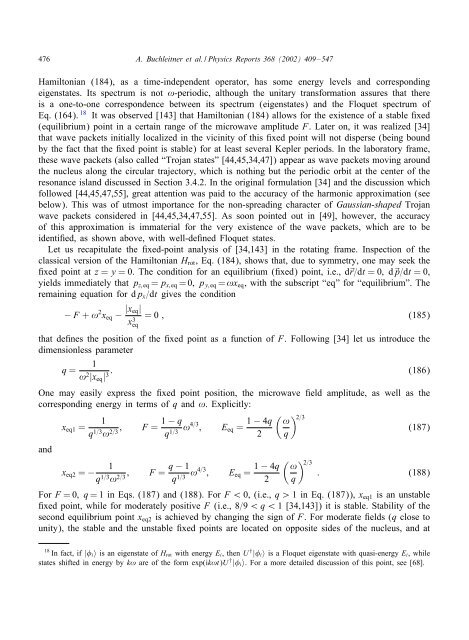Non-dispersive wave packets in periodically driven quantum systems
Non-dispersive wave packets in periodically driven quantum systems
Non-dispersive wave packets in periodically driven quantum systems
Create successful ePaper yourself
Turn your PDF publications into a flip-book with our unique Google optimized e-Paper software.
476 A. Buchleitner et al. / Physics Reports 368 (2002) 409–547<br />
Hamiltonian (184), as a time-<strong>in</strong>dependent operator, has some energy levels and correspond<strong>in</strong>g<br />
eigenstates. Its spectrum is not !-periodic, although the unitary transformation assures that there<br />
is a one-to-one correspondence between its spectrum (eigenstates) and the Floquet spectrum of<br />
Eq. (164). 18 It was observed [143] that Hamiltonian (184) allows for the existence of a stable xed<br />
(equilibrium) po<strong>in</strong>t <strong>in</strong> a certa<strong>in</strong> range of the micro<strong>wave</strong> amplitude F. Later on, it was realized [34]<br />
that <strong>wave</strong> <strong>packets</strong> <strong>in</strong>itially localized <strong>in</strong> the vic<strong>in</strong>ity of this xed po<strong>in</strong>t will not disperse (be<strong>in</strong>g bound<br />
by the fact that the xed po<strong>in</strong>t is stable) for at least several Kepler periods. In the laboratory frame,<br />
these <strong>wave</strong> <strong>packets</strong> (also called “Trojan states” [44,45,34,47]) appear as <strong>wave</strong> <strong>packets</strong> mov<strong>in</strong>g around<br />
the nucleus along the circular trajectory, which is noth<strong>in</strong>g but the periodic orbit at the center of the<br />
resonance island discussed <strong>in</strong> Section 3.4.2. In the orig<strong>in</strong>al formulation [34] and the discussion which<br />
followed [44,45,47,55], great attention was paid to the accuracy of the harmonic approximation (see<br />
below). This was of utmost importance for the non-spread<strong>in</strong>g character of Gaussian-shaped Trojan<br />
<strong>wave</strong> <strong>packets</strong> considered <strong>in</strong> [44,45,34,47,55]. As soon po<strong>in</strong>ted out <strong>in</strong> [49], however, the accuracy<br />
of this approximation is immaterial for the very existence of the <strong>wave</strong> <strong>packets</strong>, which are to be<br />
identi ed, as shown above, with well-de ned Floquet states.<br />
Let us recapitulate the xed-po<strong>in</strong>t analysis of [34,143] <strong>in</strong> the rotat<strong>in</strong>g frame. Inspection of the<br />
classical version of the Hamiltonian Hrot, Eq. (184), shows that, due to symmetry, one may seek the<br />
xed po<strong>in</strong>t at z = y = 0. The condition for an equilibrium ( xed) po<strong>in</strong>t, i.e., d˜r=dt =0; d˜p=dt =0,<br />
yields immediately that pz;eq = px;eq =0, py;eq = !xeq, with the subscript “eq” for “equilibrium”. The<br />
rema<strong>in</strong><strong>in</strong>g equation for dpx=dt gives the condition<br />
− F + ! 2 xeq − |xeq|<br />
x3 =0; (185)<br />
eq<br />
that de nes the position of the xed po<strong>in</strong>t as a function of F. Follow<strong>in</strong>g [34] let us <strong>in</strong>troduce the<br />
dimensionless parameter<br />
q =<br />
1<br />
! 2 : (186)<br />
|xeq|<br />
3<br />
One may easily express the xed po<strong>in</strong>t position, the micro<strong>wave</strong> eld amplitude, as well as the<br />
correspond<strong>in</strong>g energy <strong>in</strong> terms of q and !. Explicitly:<br />
1<br />
xeq1 =<br />
q1=3 ;<br />
! 2=3<br />
1 − q<br />
F =<br />
q1=3 !4=3 ;<br />
2=3 1 − 4q !<br />
Eeq =<br />
2 q<br />
(187)<br />
and<br />
xeq2 = − 1<br />
q1=3 ;<br />
! 2=3<br />
q − 1<br />
F =<br />
q1=3 !4=3 ;<br />
2=3 1 − 4q !<br />
Eeq =<br />
2 q<br />
: (188)<br />
For F =0;q= 1 <strong>in</strong> Eqs. (187) and (188). For F¡0, (i.e., q¿1 <strong>in</strong> Eq. (187)), xeq1 is an unstable<br />
xed po<strong>in</strong>t, while for moderately positive F (i.e., 8=9 ¡q¡1 [34,143]) it is stable. Stability of the<br />
second equilibrium po<strong>in</strong>t xeq2 is achieved by chang<strong>in</strong>g the sign of F. For moderate elds (q close to<br />
unity), the stable and the unstable xed po<strong>in</strong>ts are located on opposite sides of the nucleus, and at<br />
18 In fact, if | i〉 is an eigenstate of Hrot with energy Ei, then U † | i〉 is a Floquet eigenstate with quasi-energy Ei, while<br />
states shifted <strong>in</strong> energy by k! are of the form exp(ik!t)U † | i〉. For a more detailed discussion of this po<strong>in</strong>t, see [68].











